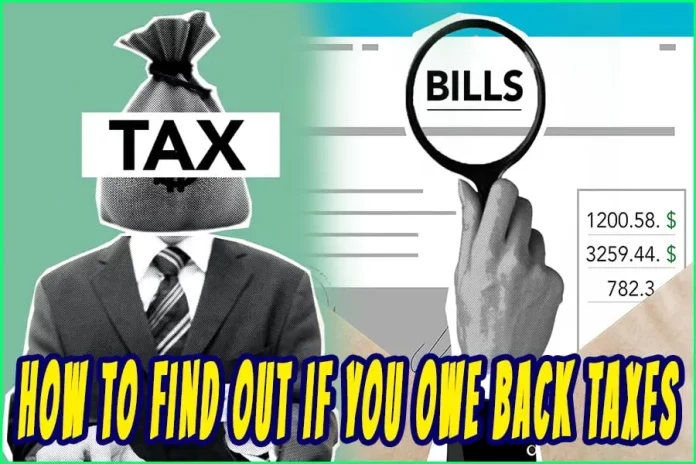If you’re like most people, you probably have no idea if you owe back taxes or not. The good news is that there are a few ways to find out. The bad news is that if you do owe back taxes, the penalties and interest can be pretty steep.
When filing your taxes, you might find out that you owe money to the IRS. If this happens, you need to take action to pay what you owe as soon as possible.
You can use several methods to determine if you owe back taxes. This article discusses these methods in more detail.
How To Find Out If You Owe Back Taxes
The best way to find out if you owe back taxes is to use the online IRS tool on the official IRS website; this tool is easy to use and will tell you if you have any outstanding tax debt.
You can also use the phone to determine if you owe back taxes by calling the IRS at 1-800-829-1040. It’s a toll-free number that will allow you to speak to a representative who can help you determine if you owe back taxes.
The third option is through the mail; you can check your account balance if you have a copy of the most recent IRS notice. However, you should note that phoning the IRS and checking online are the best options because they provide up-to-date information.
1. Check Online On the IRS Website
IRS has an online tool that allows individuals to determine if they owe back taxes; you can find it on the official website. To use the tool, you will need to have your;
- Your SSN(Social Security number)
- Your Date of birth
- Filing status (single, married, filing jointly, etc.)
- Your most recent tax return’s mailing address
- An email address and a phone number associated with your account
- An account number f that is in your name (could come from a mortgage/ home equity/ vehicle loan, or a credit card)
What information can you get using IRS online tool?
- The sum for each tax year is displayed, including the principal amount and any penalties or interest.
- It also indicates how much you owe and what you’ve paid in the previous 18 months.
- You may view letters that have been issued to you, pending payments, the amount owing by year, and even payment information with an economic impact.
- There’s also a way to get account information and return transcripts.
You should request a copy of your tax transcript from the IRS. It should show you all the transactions that have taken place on your account, including any payments you’ve made and taxes you’ve already paid.
Your balance (account balance) will only be updated once per 24 hours, generally overnight. Payments will display in your payment history in 1 to 3 weeks.
2. By Calling The IRS
The other way to find out if you owe back taxes is to call the IRS. Ensure you have your SSN and your Date of birth ready, and the IRS will be able to inform you how much you owe. They can also help you set up a payment plan if necessary.
If you’re paying your taxes, you can contact 1-800-829-1040 from 7 am- 7 pm US local time. Those representing a business can contact 1-800-829-4933 from 7 am- to 7 pm except on the weekends.
3. By Mail
You can verify your balance if you have a copy of the most recent IRS notification. It’s worth noting that the figure doesn’t include any interest or penalties that have accrued after you receive the notification.
Furthermore, the IRS frequently sends notifications that only list one year’s worth of taxes owing, so if you owe taxes for numerous years, you’ll most likely need to total up the sums on all of the notices (assuming they sent letters for all of the years that are owed).
You can acquire the updated information by checking online or phoning the IRS.
What Happens If You Owe Taxes?
If you owe taxes, the first thing you should do is contact the IRS. They will be able to help you figure out a payment plan or other solution.
If you don’t pay your taxes, the IRS can seize your assets to satisfy the debt, including your property and bank accounts.
They could lien your property or place a wage garnishment on your salary. The government can take you to court if you still don’t pay; in some cases, you may even be arrested for tax evasion.
How To File The Returns Now That You Know What You Owe
Start By Filing Your Past-Due Tax Returns
If you owe back taxes on returns that you haven’t filed yet, you can figure out how much you owe each year by preparing the actual returns.
When you do, though, you must utilize all of the tax forms for the preceding year you are submitting.
If you decide to prepare your 2020 tax return in 2022, you must utilize 2020 tax forms, schedules, and instructions. The IRS will most likely warn you if you file incorrectly using forms for a different tax year.
- It’s not tricky getting your hands on these old forms. Using tax preparation software is the most straightforward approach. It gives you access to many IRS forms from previous years.
- Alternatively, you can browse the IRS website for each form you require. However, many of those older forms on the IRS website require printing and filling out manually.
Calculate Your Interests And Penalties
IRS requires taxpayers to file their federal income tax returns by a specific deadline. In case you don’t file on time, or if you file but don’t pay what you owe, you may have to incur interest and penalties, which you have to pay.
You will need to do a few things to calculate your interest and penalties. You need to gather all your tax information for the year; this includes your W-2s, 1099s, and any other documentation related to your income or deductions.
You can calculate your tax liability when you have all of the information. If you owe taxes, you will need to calculate the interest and penalties that will be applied.
The interest is calculated based on the amount you owe, and the penalties are assessed for failure to file your return or paying your taxes on time.
- To avoid the failure- to- file penalty, you should promptly file your return or request an extension. The penalty equals 5% of the outstanding debt every month, up to a maximum penalty of 25 percent of the unpaid tax, while the interest rate for underpaid taxes is the federal short-term rate plus 3%.
Pay Your Back Taxes
No one enjoys paying their taxes, but it’s a necessary evil. If you find that you’ve landed yourself in debt to the IRS, don’t panic.
There are several ways to pay your back taxes and get back on track. Once you have an accurate figure, you can start looking for solutions.
Pay your debt in full.
You can opt to pay your back taxes in full with a debit or credit card from your bank account.
Negotiate a payment plan
If you don’t have the whole sum to cover what you owe, you should negotiate a payment plan with the IRS collection office; this allows you to break up your payments into more manageable chunks.
Alternatively, you can make an offer in compromise.
When you can’t pay your entire tax bill, the IRS may accept a lower amount as payment in full; this is called an offer in compromise. You can make this offer yourself or through a tax professional.
You’ll need to provide financial information to support your offer; this includes information about your assets, income, and expenses. The IRS will use this information to judge if you can afford to pay the total amount you owe.
This, however, is not an easy road to pursue. It will be challenging to persuade tax collectors to forgive part of the debt.
Typically, more than 60% of such offers are turned down. You have a better chance of being able to pay in installments than OIC.
If the IRS accepts your offer, you’ll have to pay the reduced amount immediately.
Conclusion
You can determine whether or not you owe back taxes using several ways. In this article, we outlined the three most common ways: checking online on the IRS website, contacting the IRS via phone, and checking your mail for any correspondence from the IRS.
We’ve also outlined the different ways you can pay your taxes. It’s crucial to know what you owe and when you are supposed to pay it so you don’t land in trouble with the IRS. We know it can be confusing, so we hope that this article has helped clear things up for you.












